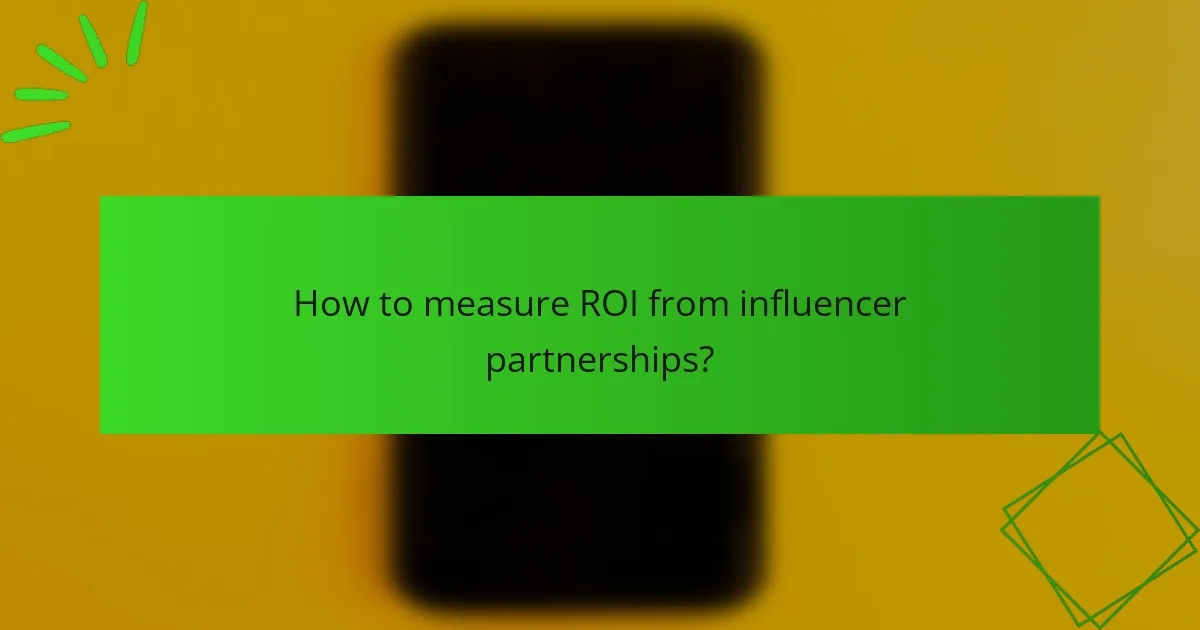Influencer partnerships can significantly enhance brand visibility and engagement when executed thoughtfully. Selecting the right influencers requires a deep understanding of your audience and alignment with brand values, while effective engagement strategies foster authentic relationships. To ensure these collaborations yield positive results, it’s essential to measure ROI through key metrics that reflect both financial returns and brand impact.

How to select the right influencers for partnerships in Canada?
Selecting the right influencers for partnerships in Canada involves understanding your target audience, evaluating potential influencers’ engagement, and ensuring alignment with your brand values. A strategic approach will enhance the effectiveness of your campaigns and maximize return on investment.
Identify audience alignment
Audience alignment is crucial when selecting influencers. Ensure that the influencer’s followers match your target demographic in terms of age, gender, interests, and geographic location. For instance, if your product is aimed at young adults in urban areas, focus on influencers who resonate with that specific group.
Utilize tools like social media analytics to gain insights into the influencer’s audience. Look for data that shows the percentage of followers in your target market to ensure effective outreach.
Evaluate engagement metrics
Engagement metrics provide insight into how actively an influencer interacts with their audience. Key metrics include likes, comments, shares, and overall engagement rate, which is typically calculated as the total engagement divided by the number of followers.
For Canadian influencers, aim for engagement rates above 2% to ensure meaningful interaction. Higher engagement often indicates a more dedicated audience, which can lead to better campaign outcomes.
Assess brand fit
Brand fit refers to how well an influencer’s values, style, and content align with your brand. An influencer who shares similar values will authentically represent your product, making their endorsement more credible.
Review the influencer’s previous content to gauge their tone and messaging. If their style aligns with your brand’s image, they are more likely to resonate with your audience and enhance brand perception.
Consider niche relevance
Niche relevance is about selecting influencers who specialize in your industry or product category. An influencer with a focused niche can provide targeted exposure and attract a more interested audience.
For example, if you sell eco-friendly products, partnering with influencers in the sustainability space can enhance credibility and attract consumers who prioritize environmental responsibility.
Review past collaborations
Examining an influencer’s past collaborations can reveal their effectiveness and reliability. Look for case studies or testimonials from previous partnerships to assess their impact on brand awareness and sales.
Consider reaching out to brands that have worked with the influencer to gather feedback on their experience. This can provide valuable insights into the influencer’s professionalism and ability to deliver results.

What are effective engagement strategies for influencers?
Effective engagement strategies for influencers focus on building authentic relationships and providing mutual benefits. By employing personalized outreach, offering value, utilizing social media platforms, and establishing clear communication, brands can enhance their partnerships with influencers.
Personalized outreach
Personalized outreach involves tailoring your communication to each influencer’s unique style and audience. Instead of generic messages, take the time to research their content and interests, which shows genuine appreciation for their work.
For example, mention specific posts or campaigns they’ve executed that resonate with your brand. This approach increases the likelihood of a positive response and fosters a stronger connection.
Offer value through products
Offering value through products means providing influencers with items that align with their interests and audience preferences. This could include free samples, exclusive access to new launches, or customized products that they can showcase to their followers.
Consider creating a product package that highlights your brand’s unique selling points. This not only enhances the influencer’s experience but also encourages authentic promotion to their audience.
Utilize social media platforms
Utilizing social media platforms effectively means choosing the right channels where your target audience and the influencer’s followers engage most. Focus on platforms like Instagram, TikTok, or YouTube, depending on where your product fits best.
Engage with influencers through stories, posts, and live sessions to create interactive content. This strategy can amplify reach and engagement, driving more attention to your brand.
Establish clear communication
Establishing clear communication is crucial for successful influencer partnerships. Set expectations regarding deliverables, timelines, and compensation upfront to avoid misunderstandings later.
Regular check-ins can help maintain alignment and address any concerns promptly. Encourage feedback and be open to suggestions, as this collaborative approach can lead to more effective campaigns.

How to measure ROI from influencer partnerships?
Measuring ROI from influencer partnerships involves assessing the financial return relative to the investment made in these collaborations. Key metrics include tracking conversions, analyzing engagement rates, evaluating brand awareness, and calculating cost per acquisition.
Track conversions through promo codes
Using unique promo codes for each influencer allows you to directly track sales generated from their audience. When customers use these codes, you can easily attribute revenue to specific partnerships, providing clear data on effectiveness.
Consider setting up a system to monitor the usage of these codes over time. This will help you identify which influencers drive the most conversions and optimize future partnerships accordingly.
Analyze engagement rates
Engagement rates, which include likes, shares, comments, and overall interaction with content, are crucial for understanding the impact of influencer partnerships. High engagement often indicates that the audience is resonating with the message, which can lead to increased brand loyalty.
To calculate engagement rates, divide the total interactions by the number of followers and multiply by 100. Aim for engagement rates in the low to mid-single digits as a benchmark, depending on the platform.
Evaluate brand awareness metrics
Brand awareness can be gauged through surveys, social media mentions, and website traffic analytics. Tracking metrics such as increased search volume or social media followers during and after an influencer campaign can indicate heightened awareness.
Consider using tools like Google Analytics to monitor traffic spikes or social listening tools to measure brand mentions before and after campaigns. This data helps assess the broader impact of influencer partnerships on your brand’s visibility.
Calculate cost per acquisition
Cost per acquisition (CPA) measures the total cost of acquiring a customer through influencer marketing. To calculate CPA, divide the total investment in influencer partnerships by the number of new customers acquired as a result.
A reasonable CPA varies by industry but should ideally be lower than the average customer lifetime value. Monitoring this metric helps ensure your influencer partnerships are financially viable and effective in driving sales.

What criteria should be used for influencer selection?
Influencer selection should be based on relevance to the target audience, authenticity, and content quality. These criteria ensure that the partnership aligns with brand values and effectively reaches potential customers.
Relevance to target audience
Choosing influencers who resonate with your target audience is crucial for effective marketing. Analyze the influencer’s follower demographics, interests, and engagement rates to ensure alignment with your brand’s goals.
Consider using tools that provide insights into audience analytics. For example, an influencer with a follower base primarily consisting of young adults may be ideal for brands targeting that age group.
Influencer authenticity
Authenticity is key to building trust with the audience. Influencers who genuinely use and believe in the products they promote tend to have higher engagement and conversion rates.
Look for influencers who share personal stories or experiences related to your brand. This can create a more relatable and trustworthy image, enhancing the effectiveness of your partnership.
Content quality
The quality of an influencer’s content directly impacts your brand’s image. High-quality visuals, engaging storytelling, and professional presentation are essential for effective communication.
Review the influencer’s previous work to assess their style and consistency. A good practice is to check their portfolio for creativity and alignment with your brand’s aesthetic.

What tools can assist in managing influencer partnerships?
Several tools can streamline the management of influencer partnerships, enhancing efficiency and effectiveness. These platforms offer analytics, outreach capabilities, and audience insights, which are crucial for optimizing collaboration and measuring success.
Influencity for analytics
Influencity provides comprehensive analytics that help brands assess influencer performance and campaign effectiveness. By tracking key metrics such as engagement rates, reach, and audience demographics, brands can make informed decisions about which influencers to partner with.
Utilizing Influencity allows for the comparison of multiple influencers side-by-side, enabling brands to identify the best fit for their target audience. This data-driven approach can significantly enhance the ROI of influencer marketing campaigns.
Upfluence for outreach
Upfluence specializes in influencer outreach, allowing brands to connect with potential partners efficiently. The platform offers tools for searching influencers based on specific criteria, such as niche, audience size, and engagement levels.
With Upfluence, brands can manage their outreach efforts through automated email campaigns and track responses. This can save time and ensure that communication is streamlined, making it easier to establish and maintain influencer relationships.
HypeAuditor for audience insights
HypeAuditor focuses on providing detailed audience insights, helping brands understand the demographics and interests of an influencer’s followers. This information is vital for ensuring that the selected influencers align with the brand’s target market.
By analyzing audience authenticity and engagement quality, HypeAuditor helps brands avoid partnerships with influencers who may have inflated follower counts or disengaged audiences. This ensures that marketing efforts are directed toward genuine connections that can drive real results.










